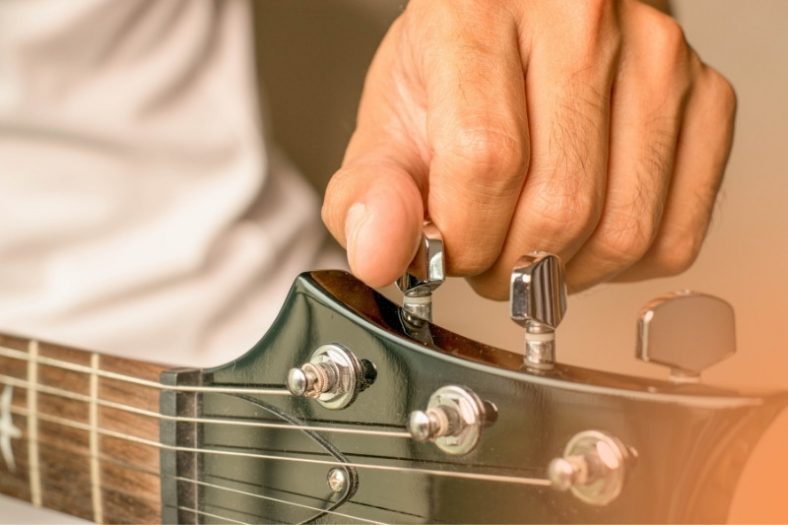9 Reasons Why Your Guitar Won’t Stay in Tune

From climate changes to poor string quality to an improper setup and many more reasons, your guitar is likely to go out-of-tune. It is one of the most frustrating problems when you play guitar, as it takes away the joy of playing your favorite songs on your beloved instrument.
From outside effects like weather to your own doings, such as your playing technique, there may be a bunch of reasons why your guitar can’t stay in tune. In this article, I will go over the most important of them to help you solve this problem for good and enjoy playing your guitar with disruptions.
Contents
1. Humidity and Temperature
One of the most common reasons that mess up your guitar’s tuning is the climate. Both humidity and temperature heavily affect the condition of your guitar as wood and metal are highly susceptible to climate changes.
High-temperature levels cause the strings to expand, while high humidity levels cause expansion on the wood components of the guitars. With the expansion of the components, the tuning will go flat.
In contrast, low-temperature and humidity levels cause the tuning to go flat as they contract the components.
Playing guitar in extreme climate conditions is extremely risky for your instrument as your guitar can get severely damaged. You might find yourself tuning your guitar pretty often if the weather conditions you live in are not ideal.
2. String Age
Another important reason for unstable tunings is old strings. Guitar strings tend to sound worse and become harder to fret as they get older.
The notes will start to sound sharp, especially on higher notes, the general tuning will be more unstable, the sound will lack sustained and become duller, and of course, they will break much easier.
When you experience any of these conditions, it means the time for a new string set has arrived. My recommendation would be to use Elixir strings as they have the most extended life and highest quality.
3. The Guitar’s ‘Nut’
The guitar’s nut may prevent your guitar from being precisely in tune if it is improperly placed or not clean. If suddenly the string jumps out of tune and you hear a “ping” sound in the process of tuning, you might want to check your guitar’s nut.
If the nut is too narrow, it pinches the strings, preventing them from moving freely and causing the tuning to shift. Another problem occurs when the nut is not flat. When the nut is not flat, it stretches the strings making the tuning unstable or breaking the strings. It can be badly cut in the first place, or the dirt may be built up over time.
You can try to lubricate the nut with oil and use graphite to clean it. If that does not work, it is better to take the guitar to a luthier.
4. String Quality
Another reason might be the quality of the strings you use, as it can also affect the tuning. Low-quality strings tend to go out of tune more often, getting affected by outside factors more than high-quality strings.
As I mentioned before, I recommend using Elixir strings which have more life and are the highest quality strings on the market.
5. Intonation
Intonation means tuning accuracy along the fretboard. If you are experiencing tuning problems only when you play fretted notes but not with open-string notes, it is highly probable you have intonation problems on your instrument.
You should check and adjust your intonation once in a while for more long-lasting tuning.
First, tune an open string to the desired note. After, check the note on the 12th fret of the same string. If the note is flat or sharp, that means that the bridge saddle needs to be moved towards or away from the headstock, respectively.
6. Tuning Pegs
Loose tuning pegs also lead the guitar to get out of tune more quickly. Be sure to tighten them, so they hold the tuning properly. If the tuning pegs move even a little bit, you should tighten the tiny screw on the tuning pegs.
7. The Pickup
You may not have guessed, but the height of the pickups affects the tuning, too. When the pickup is too high, it pulls the strings more, making the guitar go out of tune more quickly.
You should set the pickups to the correct height so that they do not push or pull the strings out of tune. If you set the pickup too low, then the magnetic field would not be optimized, which leads your tone to be worse than its potential.
8. Guitar Setup
If any of the solutions on this list do not apply to your situation, that means your guitar needs a doctor, sorry, a luthier. Just like humans, your guitar needs a check-up from time to time in order to diagnose any possible problems.
Every 6 months, you should take your guitar to a luthier for a complete guitar setup, as all of the guitars are subject to minor changes over time. If these minor changes accumulate, they may lead to more severe problems; not only will your tuning stability be affected, but much more severe problems may occur, which would negatively impact your playing.
9. Playing Technique
If you are experiencing tuning instability even after the guitar setup, that means the problem is not with your guitar, but it is with you. Poor playing technique negatively influences your tuning.
If you are playing more intensely than you should, most likely, you are causing the guitar to go out of tune regularly.
If you are fretting with too much or too little tension or if you are bending the string slightly when fretting, that means you are stretching the strings too much, making them go out of tune. Another reason might be poor vibrato or bending techniques, as these techniques use the string stretches to play with the note. If you are forcing the strings too much, that will create tuning instability.
Things That Will Help Keep Your Guitar Longer in Tune
There are plenty of things that you can do to keep your instrument in tune longer. If you do not skip any of these steps, there is a great chance that you might not experience tuning instabilities.
Regular String Changes
Change your strings regularly to have more tuning stability. Old strings go out of tune much more quickly. Remember to go with Elixir strings, if possible.
Properly Installing New Strings
The process of changing strings is very important for the instruments to stay in tune for longer. It would be best if you wrapped the strings properly to the tuning pegs for more stability. Wrapping the strings properly retains the tension and locks the strings, which will help the strings to stay in tune. You can check out this video to apply the technique properly.
After you change the string, stretch the string on the 12th, and 5th frets a couple of times until you do not experience any tuning changes. Here is a video on how to properly apply the stretching process.
Tuning Before Playing Every Time
This step is pretty straightforward. You should tune your instrument before playing every time. This will help you minimize the outside effects on your strings, like the climate changes.
You will see that if you pick up this habit for regular tuning before playing, that you just need to tighten or loosen the strings just a little bit before starting to play if done regularly.
Play Smart Not Hard
Always try to be gentle with your instrument. Playing smart instead of hard and aggressive not only will help your tuning, but it will also help you avoid any other problems that might occur.
The harder you strum and not focus on the proper technique, the more likely you will need to tune your guitar before and after playing it. More intense playing is one of the most common problems for an out-of-tune guitar.
Check The Setup Regularly For Any Changes
As I mentioned before, you should take your guitar to a luthier every 6 months for a nice setup. By doing so, you will prevent and fix any problems that may or have occurred with your instrument. So, your instrument will have better tuning stability.
Always Tune-Up To The Correct Pitch
Whenever you tune your guitar, always try to tune up to the correct pitch instead of leaving them a few cents sharp or flat. The trick here is to tune up instead of tuning down for your strings to stay in tune for longer.
You should start with the string tuned below the correct pitch, bringing it up. This way, you will avoid having slacks in the string, which can cause the string to go flat later. If the string is already above the desired pitch, first tune it down before turning it up to the correct pitch again.
Summary
Experiencing tuning instabilities is one of the most frustrating problems that take away the joy of playing your instrument. But, now you know the possible reasons and solutions as well as the things to do to avoid tuning problems.
If you closely inspect your instrument and apply the solutions of the article, there will be no reason to worry about the tuning problems.





